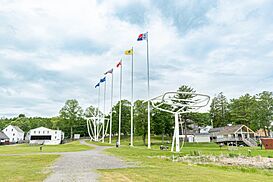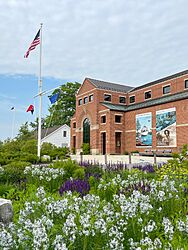Maine Maritime Museum facts for kids
The Maine Maritime Museum is a fun place to learn about Maine's long history with the sea. It shows how important ships, sailing, and the ocean have been to the state. The museum has a huge collection with millions of items, including old documents, tools, and art.
The museum is located on the shore of the Kennebec River. It includes the historic Percy and Small Shipyard, where people built large wooden ships over 100 years ago. You can see five of the original buildings from the 1800s. There is also a giant outdoor sculpture that shows the exact size of the largest wooden sailing ship ever built, the six-masted schooner Wyoming.
Contents
History of the Museum
The museum started in 1962 when seven people from Bath, Maine, created the Marine Research Society of Bath. At first, they just rented a small shop to show their collection. In 1964, a wealthy shipbuilding family named the Sewalls gave the museum their large house to use.
The museum was called the Bath Marine Museum until 1972, when it was renamed the Maine Maritime Museum. For a while, the museum's collection was spread out in three different places. Visitors even had to take a ferry to get between some of the exhibits.
In 1989, the museum moved to its current location. A new, modern building was built right next to the old Percy & Small Shipyard. This brought everything together in one place for the first time.
What's in the Collection?
The museum has a collection of over 20,000 objects, plus millions of documents like letters and ship plans. These items tell the story of Maine's connection to the sea, from ancient times to today.
The collection helps us understand many things, such as:
- How Maine's ships traveled around the world.
- How families in Maine ran their shipbuilding businesses.
- How fishing, especially for lobster, is important to Maine.
- How Maine's beautiful coast became a popular place for tourists.
- How artists have shown Maine's ships, people, and coast in their work.
You can even see a lot of the collection online for research.
Exhibits and Tours
The museum has many amazing permanent exhibits.
- The Donnell House: You can walk through the restored 1892 home of a shipyard owner and see how he lived.
- A Shipyard in Maine: Percy & Small and the Great Schooners: This exhibit shows you America's only preserved shipyard where giant wooden sailing ships were built.
- BIW: Building America's Navy: Made with Bath Iron Works, this exhibit uses cool technology to show how modern Navy ships are built today.
- Historic Boat Collection: See more than 140 boats that were built in or connected to Maine. The collection includes everything from a rare birch bark canoe to a type of sailboat called a Friendship sloop.
- Into the Lantern: A Lighthouse Experience: Step inside a life-sized copy of the top of the Cape Elizabeth Two Lights lighthouse. You can see the real, huge Fresnel lens that once guided ships safely to shore.
- Kenneth D. Kramer Blacksmith Shop: Watch a real blacksmith at work in a shop that looks just like the one that was here in the 1900s.
- Lobstering & the Maine Coast: Learn all about Maine's famous lobstering industry.
In the summer, you can also see the museum's own historic ship, the schooner Mary E. It was built in Bath in 1906 and is the oldest fishing schooner from Maine that is still sailing.
The Museum Campus
The most famous feature on the museum's campus is the giant sculpture of the schooner Wyoming. The real Wyoming was the largest wooden ship ever built in the United States, but it sank in a storm in 1924. In 2001, the museum built this huge outdoor art piece to show visitors just how big the ship was. It is 444 feet long, making it the largest sculpture in New England!
The museum's main gallery building was finished in 1989. It was designed to protect the museum's valuable collection. In 2019, the museum began a project to improve its entrance and the land along the river, making it more beautiful and easier for everyone to visit.
See also
- List of maritime museums in the United States
- List of museums in Maine
- List of museum ships
- National Register of Historic Places listings in Sagadahoc County, Maine
Gallery







